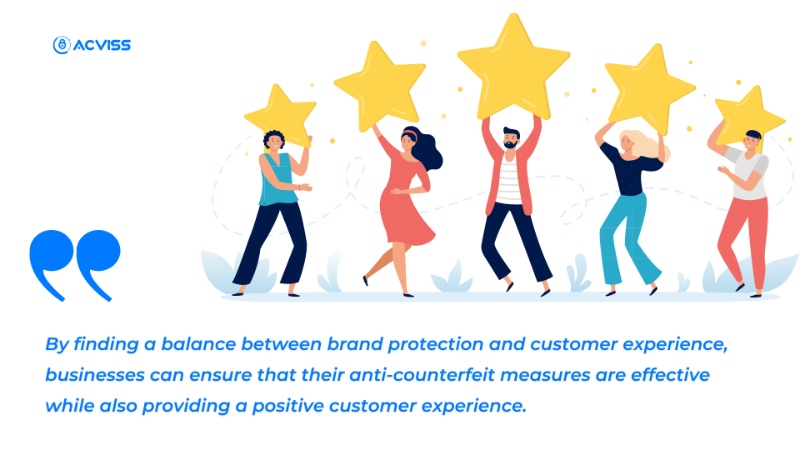Know How Anti-Counterfeit Measures Can Impact Customer Experience

Counterfeit products are renowned to be a threat to brand reputation, business loss and tax evasion. But they pose an even greater problem, tarnishing the user’s experience. Customers are the backbone of any brand or industry and anything which disrupts their experience has an immense impact on the functioning of the business itself. It is estimated that 86% of customers are willing to pay more just for solely experiencing the product or service. To tackle this issue, companies are taking measures to prevent counterfeit products from entering the market. While these measures are essential, they can also impact the customer experience.
Why are Anti-Counterfeit Measures Necessary?
Counterfeit products can cause significant harm to businesses and consumers. For businesses, counterfeits reduce sales, damage brand reputation and cut into profit margins. For consumers, counterfeit products can pose serious health and safety risks, especially when it comes to products like medicine, electronics, and children's toys. Counterfeit products may not meet the quality standards of legitimate products, leading to dissatisfaction and lost trust in the brand.
In an age where customer experience and service overtakes price and product as key differentiators. Businesses must take various measures to combat counterfeiting. Solutions like security labels, embedding security features, conducting product authentication, and enforcing legal action are effective in preventing counterfeiting. However, these measures can also impact the customer experience.
How anti-counterfeiting can enhance the experience.
Quality
Firstly, anti-counterfeiting measures help to ensure that customers receive genuine products. Counterfeit products are often of inferior quality and do not meet the same standards as genuine products. This can result in a negative customer experience, with customers feeling cheated or dissatisfied with their purchase. By using anti-counterfeiting measures, businesses can help to ensure that customers receive genuine products and feel satisfied with their purchases, knowing that they are not being sold counterfeit or substandard goods. One such company which has been adored by the public is Nike. The sports brand has been successful in implementing an anti-counterfeiting solution called Nike connect, which helps customers to verify the authenticity of their products without being scammed by fraudsters.
Safety
Counterfeit products may not meet the safety standards required by law, leading to potential harm to the customers. By implementing anti-counterfeit solutions, businesses can improve customer experience by assuring them that the products they are buying are safe and meet all necessary standards. Pfizer, a world-renowned pharmaceutical company has employed a serialization process on their product packaging so that customers can cross-verify the product on their website. This gives customers peace of mind, knowing that the product they are buying will not pose any danger to them or their loved ones.
Trust
To build trust and loyalty with customers brands have to invest in protecting their interests. Customers are more likely to trust and remain loyal to brands that take measures to protect them from counterfeit products. By using anti-counterfeiting measures, businesses demonstrate their commitment to customer safety and quality, which can help to build trust and loyalty with customers. This, in turn, leads to a better customer experience, as customers are more likely to return to a brand they trust and recommend it to others.
Reputation
Finally, anti-counterfeiting measures can help to prevent price erosion. Counterfeit products are often sold at a lower price than genuine products, which can erode the value of genuine products in the eyes of customers. By using anti-counterfeiting measures, businesses can help to prevent price erosion, ensuring that customers perceive their products as valuable and worth paying for. This can lead to a better customer experience, as customers are more likely to perceive the product as worth the price they paid for it. The famous diamond distributor, De Beers has used blockchain technology to make sure they only supply quality diamonds that are not blood diamonds or are able to provide the info about where the diamond was collected from. This creates a sense of trust in the customers and moreover brings brand loyalty and increases brand reputation.
How to improve customer experience
Simplify the Authentication Process
One way to improve the customer experience is to simplify the authentication process. For example, businesses can use 2D codes like QR codes or proprietary codes or NFC technology to provide a seamless authentication experience. This approach can eliminate the need for customers to visit a website or call a support centre, making the authentication process more convenient and user-friendly.
Enforcing Legal Action
Legal action can help deter counterfeiters and protect legitimate businesses. However, legal action can be a slow and expensive process, and customers may not see the impact of legal action on their immediate purchase. Moreover, legal action can give customers a negative impression of the brand if seen as too aggressive or belligerent.
Educate Customers
Another strategy is to educate customers about anti-counterfeit measures. Businesses can use packaging or other materials to explain the importance of anti-counterfeit measures and how customers can authenticate their products. By educating customers, businesses can improve the customer experience by reducing confusion and increasing trust.
Collaborate with your audience
Collaborating with customers is an excellent way to improve the customer experience moreover enhance customer engagement which will benefit the brand even more in the long run. For example, businesses can ask for feedback from customers about their anti-counterfeit measures and use that feedback to improve the customer experience. By involving customers in the process, businesses can build trust and loyalty.

In Short!
Anti-counterfeit measures are essential for protecting businesses and consumers from the harmful effects of counterfeit products. However, these measures can also impact the customer experience. By finding a balance between brand protection and customer experience, businesses can ensure that their anti-counterfeit measures are effective while also providing a positive customer experience.